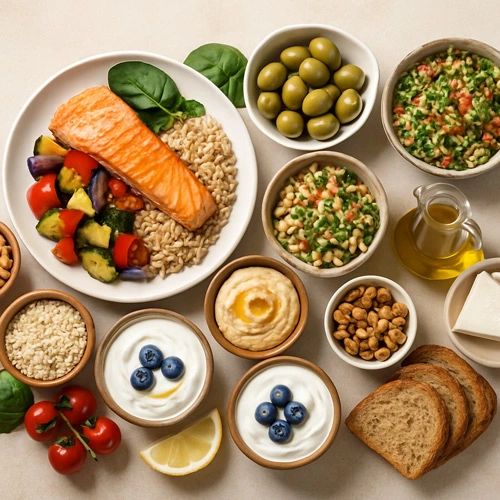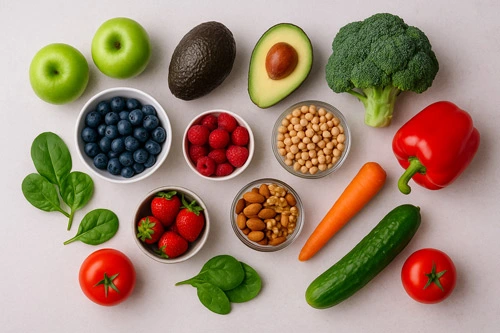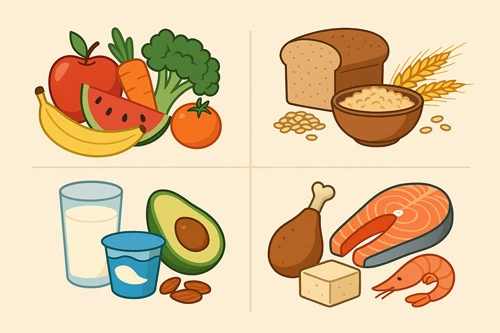Introduction to the Mediterranean Diet
In a world flooded with fad diets and quick-fix weight loss solutions, the Mediterranean diet stands out as a timeless, science-backed approach to health and wellness. Rooted in the traditional eating patterns of countries bordering the Mediterranean Sea—such as Greece, Italy, and southern Spain—this diet is more than just a temporary fix; it’s a sustainable lifestyle that emphasizes balance, variety, and real food.
Unlike restrictive plans that eliminate entire food groups, the Mediterranean diet embraces a wide range of wholesome ingredients. From colorful vegetables and fruits to whole grains, legumes, nuts, seeds, and heart-healthy olive oil, its food list is rich, diverse, and satisfying. Fresh fish, lean poultry, and occasional red wine are included in moderation, while processed foods and added sugars are minimized. This approach is often visualized through the Mediterranean diet pyramid, a helpful tool that illustrates the recommended daily and weekly servings of various food categories.
One of the reasons this diet has gained worldwide popularity is its flexibility. Whether you’re looking for healthy recipes, a long-term meal plan, or simply a better way to enjoy breakfast, lunch, and dinner, the Mediterranean diet can be easily tailored to fit your needs. It’s ideal for busy individuals who need breakfast on the go, people seeking meal prep options, or even those who want to explore breakfast without eggs or region-specific versions like the UK or Australia styles.
Many health professionals recommend this diet not only for weight loss but also for reducing the risk of heart disease, diabetes, and inflammation. And if you’re just getting started, a simple shopping list and a downloadable Mediterranean diet PDF guide can make the transition seamless and enjoyable.
In the sections that follow, we’ll explore everything you need to know—from how to build your Mediterranean meal plan to delicious Mediterranean diet recipes, breakfast ideas, and practical shopping tips—so you can confidently embrace this vibrant and flavorful way of eating.
Core Principles of the Mediterranean Diet
At its heart, the Mediterranean diet is not just about individual meals—it’s about an overall pattern of eating that reflects the traditional dietary habits of Mediterranean cultures. These communities have long been admired for their longevity and low rates of chronic disease, and much of their health can be traced back to what—and how—they eat.
The foundation of this diet is beautifully illustrated in the Mediterranean diet pyramid, a visual representation that emphasizes the frequency and proportion of different food groups. At the base of the pyramid, we find the staples of everyday eating: vegetables, fruits, whole grains, legumes, nuts, seeds, and olive oil. These form the core of most Mediterranean diet meals and are consumed daily in generous amounts.
Moving up the pyramid, you’ll find moderate consumption of fish and seafood, recommended at least twice a week. These provide essential omega-3 fatty acids and lean protein. Poultry, eggs, cheese, and yogurt are included in smaller quantities, while red meat and sweets are reserved for special occasions.
Beyond the ingredients themselves, the Mediterranean diet also highlights how we eat. Meals are meant to be enjoyed slowly, often shared with family or friends, and accompanied by physical activity and mindfulness. This holistic approach is a big part of why the Mediterranean way of eating is considered more of a lifestyle than a restrictive diet.
Portion control, variety, and seasonal eating are also essential principles. Rather than following rigid calorie counts, the Mediterranean diet encourages listening to your body’s natural hunger cues while enjoying nutrient-rich foods that keep you full and energized throughout the day.
Whether you’re preparing a hearty lunch, a simple breakfast, or planning your weekly meal prep, understanding these core principles is key to successfully adopting and benefiting from the Mediterranean diet. In the next section, we’ll dive deeper into the specific foods you should prioritize and those to limit, using a complete Mediterranean diet food list and shopping list to get you started.
learn more: Dr Now Diet Plan: A Complete Guide to Effective Weight Loss
Mediterranean Diet Food List: What to Eat and Avoid
One of the reasons the Mediterranean diet is so sustainable and enjoyable is its rich variety of flavorful, wholesome foods. Whether you’re crafting a full Mediterranean meal plan or just looking to upgrade your daily eating habits, having a clear and practical Mediterranean diet food list is the perfect starting point.
Here’s a breakdown of what to include—and what to limit—when building your Mediterranean diet shopping list:
Foods to Eat Frequently
These form the foundation of most Mediterranean diet meals and should make up the bulk of your grocery haul:
-
Vegetables: spinach, kale, tomatoes, cucumbers, eggplant, zucchini, bell peppers
-
Fruits: oranges, apples, grapes, berries, melons, figs
-
Whole Grains: brown rice, oats, quinoa, bulgur, barley, whole wheat bread and pasta
-
Legumes: lentils, chickpeas, beans (white, black, cannellini)
-
Nuts & Seeds: almonds, walnuts, sunflower seeds, flaxseeds, chia seeds
-
Healthy Fats: extra virgin olive oil (the primary fat source in the diet)
-
Herbs & Spices: basil, oregano, rosemary, thyme, garlic, cumin
-
Fish & Seafood: salmon, sardines, tuna, trout, mackerel (at least 2x/week)
-
Dairy (in moderation): plain Greek yogurt, feta cheese, part-skim cheese
-
Beverages: plenty of water, herbal teas, occasional red wine (optional and in moderation)
Foods to Eat Occasionally or in Moderation
These foods are not forbidden, but should be limited to maintain the health benefits of the diet:
-
Poultry: chicken or turkey (1–2 times per week)
-
Eggs: up to 4–7 per week (unless limited in specific breakfast meal plans)
-
Dairy: milk, butter, cream (use sparingly and choose low-fat versions)
Foods to Avoid or Minimize
These are discouraged in the Mediterranean lifestyle due to their inflammatory or highly processed nature:
-
Processed Meats: bacon, sausage, deli meats
-
Refined Grains: white bread, white rice, sugary cereals
-
Added Sugars: soda, pastries, candy, desserts with high-fructose corn syrup
-
Fast Food & Fried Items: burgers, fries, pizza from fast food chains
-
Highly Processed Snacks: chips, packaged cookies, crackers
Example Mediterranean Diet Shopping List
Here’s a simple shopping list to help you get started with a week of Mediterranean diet meals:
-
Fresh produce: spinach, tomatoes, cucumbers, onions, lemons
-
Fruits: bananas, apples, grapes
-
Grains: whole wheat pasta, brown rice, oats
-
Protein: canned tuna, fresh salmon, eggs, Greek yogurt, chickpeas
-
Nuts: almonds, walnuts
-
Pantry staples: olive oil, balsamic vinegar, garlic, herbs
-
Extras: feta cheese, olives, whole grain bread
Whether you’re preparing meals for a full week or just exploring new recipes, using a detailed Mediterranean diet food list ensures you’re stocked with everything you need. This not only makes your shopping list more efficient but also keeps your meals balanced, nutritious, and aligned with the Mediterranean pyramid guidelines.
Up next, we’ll build a practical 7-day Mediterranean meal plan to show you exactly how to turn these foods into delicious and satisfying meals—breakfast, lunch, and dinner included.
learn more: Calorie Deficit Diet: Your Ultimate Guide to Sustainable Weight Loss
7-Day Mediterranean Diet Meal Plan: Breakfast, Lunch, and Dinner Ideas
One of the best aspects of the Mediterranean diet is its flexibility and ease of integration into everyday life. With the right planning, you can enjoy flavorful, satisfying meals that align with your health goals. Below is a complete 7-day Mediterranean diet meal plan that includes breakfast, lunch, and dinner options—perfect for beginners or anyone looking to refresh their routine.
Each day offers a variety of nutrient-dense ingredients inspired by traditional Mediterranean cuisine. Let’s dive in:
🥗 Day 1
-
Breakfast: Greek yogurt with honey, walnuts, and fresh berries
-
Lunch: Quinoa salad with chickpeas, cucumber, tomato, feta cheese, and olive oil
-
Dinner: Grilled salmon with roasted vegetables and a side of brown rice
🥗 Day 2
-
Breakfast: Whole grain toast with avocado, cherry tomatoes, and olive oil drizzle
-
Lunch: Lentil soup with whole grain bread and a mixed green salad
-
Dinner: Baked chicken with lemon, garlic, and rosemary served with couscous and steamed broccoli
🥗 Day 3
-
Breakfast: Oatmeal with sliced apples, cinnamon, and almonds
-
Lunch: Mediterranean wrap with hummus, grilled vegetables, and spinach in a whole wheat tortilla
-
Dinner: Grilled shrimp with whole wheat pasta, cherry tomatoes, spinach, and basil
🥗 Day 4
-
Breakfast: Chia pudding with almond milk, figs, and crushed pistachios
-
Lunch: Tabbouleh with falafel and tahini dressing
-
Dinner: Stuffed bell peppers with quinoa, black beans, tomatoes, and herbs
🥗 Day 5
-
Breakfast: Cottage cheese with sliced melon and a handful of walnuts
-
Lunch: Grilled eggplant and zucchini over barley with a side of tzatziki
-
Dinner: Baked trout with herbs, lemon, and a Mediterranean-style potato salad
🥗 Day 6
-
Breakfast: Smoothie with banana, spinach, Greek yogurt, and chia seeds (great breakfast on the go)
-
Lunch: Chickpea and vegetable stir-fry with olive oil and garlic
-
Dinner: Roasted chicken thighs with sweet potatoes and sautéed kale
🥗 Day 7
-
Breakfast: Scrambled eggs with spinach and feta (or breakfast without eggs: try hummus and whole grain crackers with cucumber slices)
-
Lunch: Grilled veggie and halloumi cheese salad with balsamic glaze
-
Dinner: Seafood paella with brown rice, mussels, shrimp, peas, and red pepper
Meal Prep Tips:
-
Prepare grains (quinoa, rice, oats) in bulk at the beginning of the week.
-
Chop vegetables in advance for easy access.
-
Store snacks like nuts, olives, or hummus in small containers for quick grab-and-go options.
-
Create breakfast meal prep jars like overnight oats or yogurt parfaits.
This Mediterranean diet meal plan not only aligns with the Mediterranean pyramid, but also helps you stick to your shopping list, minimize food waste, and make your weekly cooking enjoyable and efficient.
In the next section, we’ll provide some of the best Mediterranean diet recipes you can try at home—simple, delicious, and packed with nutrition.
Mediterranean Diet Recipes You Can Try Today
One of the most enjoyable parts of adopting the Mediterranean diet is discovering how delicious healthy eating can be. With its rich flavors, fresh herbs, and heart-healthy ingredients, Mediterranean cooking offers endless variety. Whether you’re a beginner or a seasoned home cook, these handpicked Mediterranean diet recipes will help you create flavorful meals that align with your weekly meal plan.
Here are six simple, satisfying recipes you can try at home today—covering breakfast, lunch, and dinner options.
1. Mediterranean Chickpea Salad (Lunch or Side Dish)
Ingredients:
-
1 can chickpeas (rinsed and drained)
-
1 cucumber (diced)
-
1 red bell pepper (chopped)
-
½ red onion (thinly sliced)
-
Handful of cherry tomatoes (halved)
-
2 tbsp olive oil, juice of 1 lemon
-
Salt, pepper, parsley to taste
Instructions:
In a large bowl, combine all ingredients. Toss well and serve chilled.
2. Spinach and Feta Breakfast Wrap
Perfect for: A quick, protein-rich Mediterranean diet breakfast
Ingredients:
-
2 eggs (or use tofu for egg-free version)
-
1 handful spinach
-
¼ cup crumbled feta
-
Whole grain tortilla
-
Olive oil
Instructions:
Sauté spinach in olive oil. Scramble eggs, combine with feta and spinach, and wrap in tortilla.
3. Grilled Lemon-Herb Chicken with Couscous (Dinner)
Ingredients:
-
2 chicken breasts
-
Juice of 1 lemon
-
2 cloves garlic (minced)
-
1 tsp oregano
-
1 tbsp olive oil
-
1 cup whole wheat couscous
-
Steamed broccoli or side salad
Instructions:
Marinate chicken in lemon, garlic, oregano, and olive oil for 30 minutes. Grill and serve with cooked couscous and vegetables.
4. Roasted Veggie Bowl with Hummus
Perfect for: Lunch or meal prep
Ingredients:
-
Zucchini, eggplant, red bell peppers
-
Olive oil, salt, pepper
-
1 cup cooked quinoa
-
2 tbsp hummus
Instructions:
Roast chopped vegetables at 200°C (400°F) for 25–30 minutes. Serve over quinoa with hummus on the side.
5. Mediterranean Tuna Pasta Salad (Cold Dinner or Lunch)
Ingredients:
-
Whole grain pasta (cooked and cooled)
-
1 can tuna in olive oil
-
Cherry tomatoes, olives, capers, red onion
-
Olive oil, lemon juice, basil
Instructions:
Mix all ingredients in a large bowl and refrigerate before serving. Ideal for lunchboxes or a light dinner.
6. Greek Yogurt with Honey & Walnuts
Perfect for: Breakfast, snack, or even dessert
Ingredients:
-
1 cup plain Greek yogurt
-
1 tsp raw honey
-
Handful of crushed walnuts
-
Optional: fresh figs or berries
Instructions:
Layer the yogurt with honey and walnuts. Add fruit if desired. Ready in under 2 minutes!
Recipe Tips:
-
Use extra virgin olive oil as your main cooking fat.
-
Herbs like oregano, basil, and rosemary can dramatically enhance flavor.
-
Prepare larger portions for meal prep and use leftovers creatively.
These Mediterranean diet recipes are quick, versatile, and adaptable to various dietary needs, including breakfast without eggs, low-sodium versions, or vegetarian options. In the next section, we’ll explore Mediterranean-style breakfasts in more depth—including regional favorites from the UK and Australia, ideas for weight loss, and smart meal prep tips.
learn more: GOLO Diet: Complete Guide to Meal Plans, Side Effects, Reviews, and Recipes
Mediterranean Diet Breakfast Ideas and Recipes
When it comes to building a healthy eating routine, starting your day right is essential. With the Mediterranean diet, breakfast is more than just a quick meal—it’s an opportunity to fuel your body with wholesome, nutrient-dense foods that keep you satisfied and energized throughout the morning.
Whether you’re looking for Mediterranean diet breakfast ideas, planning a breakfast meal prep, or needing a healthy breakfast on the go, this diet offers a wide range of delicious options.
🌞 1. Classic Mediterranean Diet Breakfast Essentials
A typical Mediterranean diet breakfast includes combinations of the following:
-
Fresh fruits (like berries, apples, figs)
-
Whole grains (such as oats, whole grain bread, or barley)
-
Healthy fats (especially extra virgin olive oil and nuts)
-
Dairy (like plain Greek yogurt or feta cheese)
-
Lean proteins (eggs, or plant-based sources like hummus)
These foods create a balanced plate filled with fiber, protein, and healthy fats—helping to reduce cravings and regulate blood sugar.
🥗 2. Easy Mediterranean Diet Breakfast Recipes for Weight Loss
If your goal is weight management, the Mediterranean diet breakfasts for weight loss emphasize whole foods that are low in added sugar and high in satiety. Here are a few easy, filling ideas:
-
Greek Yogurt with Berries and Chia Seeds
-
Vegetable Omelet with Spinach, Tomato, and Feta
-
Oats Cooked in Almond Milk Topped with Walnuts and Fresh Pears
-
Hummus and Sliced Avocado on Whole Grain Toast
These breakfast recipes for weight loss are rich in protein and fiber, keeping you full longer and helping you avoid unhealthy snacking later in the day.
🚶♀️ 3. Mediterranean Diet Breakfast on the Go
For busy mornings, you can still stick to your Mediterranean habits with quick, portable options. Here are some breakfast on the go ideas:
-
Overnight oats with almonds and raisins
-
Whole wheat pita stuffed with hummus and cucumbers
-
Fruit and nut trail mix with a hard-boiled egg
-
Homemade energy bars made with dates and oats
All of these can be prepared in advance and grabbed from the fridge as you head out the door.
🍱 4. Mediterranean Breakfast Meal Prep Tips
Planning ahead makes it easier to follow the Mediterranean diet breakfast meal prep approach. Consider these tips:
-
Prepare a batch of overnight oats for 3–4 mornings
-
Boil eggs at the start of the week
-
Chop fruits and store them in portioned containers
-
Pre-bake whole grain muffins with olive oil and spinach
Meal prepping makes your mornings smooth and ensures you stay consistent with your diet goals.
🍳 5. Mediterranean Diet Breakfast Without Eggs
Not everyone wants or tolerates eggs in the morning. Fortunately, the Mediterranean diet breakfast without eggs still offers plenty of variety:
-
Avocado toast with olive oil and za’atar
-
Fruit salad with nuts and Greek yogurt
-
Chickpea pancakes (also called “socca”) with herbs
-
Oatmeal topped with tahini and dates
These dishes are flavorful, plant-based, and easy to adapt for various dietary preferences.
🇬🇧 6. Mediterranean Diet Breakfast UK Style
In the UK, people often look for easy-to-make Mediterranean-inspired breakfasts with ingredients available locally. Here are a few examples:
-
Grilled tomatoes on toast with olive oil drizzle
-
Sautéed mushrooms with garlic and parsley on rye bread
-
Greek-style yogurt parfait with oats, berries, and honey
These options align with the Mediterranean pyramid and are easy to find in UK supermarkets.
🇦🇺 7. Mediterranean Diet Breakfast Australia Style
Australian-style Mediterranean breakfasts lean into fresh, colorful ingredients and minimalist prep. Here are a few examples:
-
Smashed avocado with dukkah and poached eggs
-
Smoothie bowl with seasonal fruits, granola, and almond butter
-
Whole grain toast with hummus, beetroot, and spinach
These combinations bring a fresh twist to traditional Mediterranean eating while embracing Australia’s diverse food culture.
🔄 Breakfast, Lunch, and Dinner as a Lifestyle
As you can see, the Mediterranean diet breakfast, along with lunch and dinner, is about making smart choices and enjoying real food. You don’t need to sacrifice flavor or convenience—just follow the principles of variety, simplicity, and balance.
In the next section, we’ll guide you through how to create a smart shopping list to make your Mediterranean lifestyle both practical and budget-friendly.
How to Create a Mediterranean Diet Shopping List
One of the best ways to stay consistent with your Mediterranean diet goals is to start with a well-organized shopping list. A clear and strategic Mediterranean diet shopping list helps you save time, stick to your meal plan, avoid unhealthy choices, and build flavorful, nutritious meals all week long.
Here’s how to structure your Mediterranean shopping list, broken down by food group:
🫒 1. Healthy Fats
Healthy fats are a foundation of the Mediterranean diet. Make sure your pantry always includes:
-
Extra virgin olive oil (your #1 cooking oil)
-
Avocados
-
Nuts: almonds, walnuts, pistachios
-
Seeds: chia seeds, flaxseeds, sunflower seeds
-
Natural nut butters (without added sugar or hydrogenated oils)
🥬 2. Fresh Vegetables
Aim for color and variety! Choose at least 4–6 different types each week:
-
Spinach, kale, arugula
-
Tomatoes, cucumbers, bell peppers
-
Zucchini, eggplant, broccoli
-
Red onions, garlic, leeks
-
Carrots, sweet potatoes
🍎 3. Fresh Fruits
Fresh fruit is a daily part of Mediterranean eating—ideal for breakfast, snacks, or dessert.
-
Apples, pears
-
Figs, dates
-
Berries: strawberries, blueberries, raspberries
-
Oranges, mandarins, grapes
-
Melons and pomegranate
🥖 4. Whole Grains
These are essential for breakfasts, lunches, and even meal prep.
-
Oats (for overnight oats or porridge)
-
Whole grain bread and pita
-
Brown rice, quinoa, bulgur
-
Whole wheat pasta
-
Barley, couscous
🧀 5. Dairy (Mostly from Yogurt and Cheese)
Mediterranean dairy is typically eaten in moderation, focusing on quality.
-
Plain Greek yogurt (for snacks or breakfast)
-
Feta cheese
-
Ricotta or cottage cheese
-
Parmesan or hard cheeses (in small amounts)
🍗 6. Lean Protein: Meat, Fish & Plant-Based
For balanced meals throughout your week:
-
Chicken breast, turkey
-
Eggs (or tofu/tempeh if avoiding eggs)
-
Fresh or canned tuna in olive oil
-
Salmon, sardines, or mackerel
-
Legumes: chickpeas, lentils, beans
-
Hummus (great for breakfast without eggs or light lunch)
🧂 7. Herbs, Spices & Pantry Staples
These ingredients make your Mediterranean diet recipes pop with flavor:
-
Dried oregano, basil, thyme, rosemary
-
Cumin, paprika, cinnamon
-
Tahini
-
Canned tomatoes
-
Capers, olives
-
Lemon, vinegar (especially balsamic)
📦 8. Optional Convenience Items (for Meal Prep & On the Go)
-
Whole grain wraps or tortillas
-
Pre-cut veggie packs
-
Canned beans
-
Frozen berries for smoothies
-
Ready-made hummus or tzatziki
-
Unsweetened almond or oat milk
📝 Pro Tips for Mediterranean Grocery Shopping
-
Plan your meals ahead of time using a printable or digital Mediterranean diet PDF or checklist.
-
Stick to the perimeter of the store—where the fresh foods are.
-
Avoid overly processed items or foods high in added sugar and preservatives.
-
Shop once or twice a week to keep ingredients fresh.
-
Choose organic produce and sustainable seafood when possible.
By keeping this Mediterranean diet shopping list handy, you’ll always be prepared to make healthy choices. Whether you’re planning your next breakfast, prepping meals for weight loss, or trying new recipes, the right ingredients are key to Mediterranean success.
Downloadable Mediterranean Diet PDF Guide
To make it even easier for you to follow the Mediterranean diet, we’ve created a convenient and beautifully designed Mediterranean diet PDF guide you can download, print, or save to your phone.
Whether you’re planning your meals for the week, creating your shopping list, or looking for easy Mediterranean diet recipes, this PDF contains everything you need in one place.
📄 What’s Inside the Mediterranean Diet PDF?
This free PDF guide includes:
✅ A complete 7-day Mediterranean diet meal plan
✅ A categorized shopping list for easy grocery runs
✅ Quick and easy breakfast, lunch, and dinner recipes
✅ Breakfast ideas for busy mornings or meal prep
✅ Tips for breakfasts without eggs or dairy-free options
✅ Adaptations for UK and Australia regional ingredients
✅ A printable Mediterranean diet pyramid visual guide
🎯 Why You Should Download the Mediterranean Diet PDF
-
Save time during your weekly planning
-
Stay consistent with your nutrition goals
-
Track your meals more effectively
-
Easy to reference while shopping or cooking
-
Perfect for both beginners and long-time followers of the diet
You’ll no longer need to scroll through multiple pages to find what you need—just open your guide and go.
🔗 Get Your Free Mediterranean Diet PDF
Click the button below to download the full Mediterranean diet PDF guide instantly and begin your journey toward healthier, more enjoyable eating today.
With the right tools, a flexible meal plan, and the motivation to eat well, living the Mediterranean lifestyle becomes second nature. From breakfast on the go to satisfying dinners, you’ll enjoy every bite—knowing you’re doing something amazing for your body and mind.
Tips for Sticking to the Mediterranean Diet Long Term
Adopting the Mediterranean diet is about embracing a lifestyle, not just following a temporary meal plan. To help you stay on track and enjoy lasting benefits, consider these practical tips:
-
Plan Ahead: Use a detailed Mediterranean diet meal plan and prepare your shopping list weekly to avoid impulsive, unhealthy choices.
-
Meal Prep: Preparing your Mediterranean diet breakfast meal prep or lunches in advance can save time and reduce stress on busy days.
-
Enjoy Social Meals: Share meals with family and friends whenever possible, reflecting the Mediterranean culture of communal eating.
-
Stay Active: Combine your diet with regular physical activity for optimal health benefits.
-
Be Flexible: Don’t stress over perfection. Adapt recipes and meals to your tastes and local ingredient availability, like in the UK or Australia.
-
Hydrate Smartly: Prioritize water and limit sugary drinks, aligning with Mediterranean principles.
-
Listen to Your Body: Eat mindfully and stop when satisfied, not stuffed.
By integrating these habits, the Mediterranean diet becomes more than food choices—it becomes a sustainable, enjoyable way to live.
🎯 Conclusion: Embrace the Mediterranean Lifestyle for Lasting Health
The Mediterranean diet combines rich flavors, wholesome ingredients, and a balanced approach to eating that supports heart health, weight management, and overall well-being. Whether you start by trying out simple Mediterranean diet breakfast recipes, following a full meal plan, or using our detailed shopping list, this diet offers flexibility and enjoyment.
Remember, the key to success is consistency and making the diet your own, whether that means preparing quick breakfasts on the go, trying a breakfast without eggs, or exploring regional variations like the Mediterranean diet breakfast UK or Australia styles.
By choosing fresh, nutrient-dense foods and embracing the social and mindful eating habits of Mediterranean cultures, you’re setting yourself up for a healthier, happier life.






